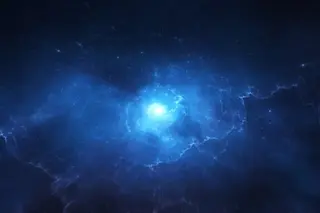Here's a tale of modern physics: Two scientists work at the same university in different fields. One studies huge objects far from Earth. The other is fascinated by the tiny stuff right in front of him. To satisfy their curiosities, one builds the world's most powerful telescope, and the other builds the world's best microscope. As they focus their instruments on ever more distant and ever more minuscule objects, they begin to observe structures and behaviors never before seen — or imagined. They are excited but frustrated because their observations don't fit existing theories.
One day they leave their instruments for a caffeine break and happen to meet in the faculty lounge, where they begin to commiserate about what to make of their observations. Suddenly it becomes clear to both of them that although they seem to be looking at opposite ends of the universe, they are seeing the same ...














